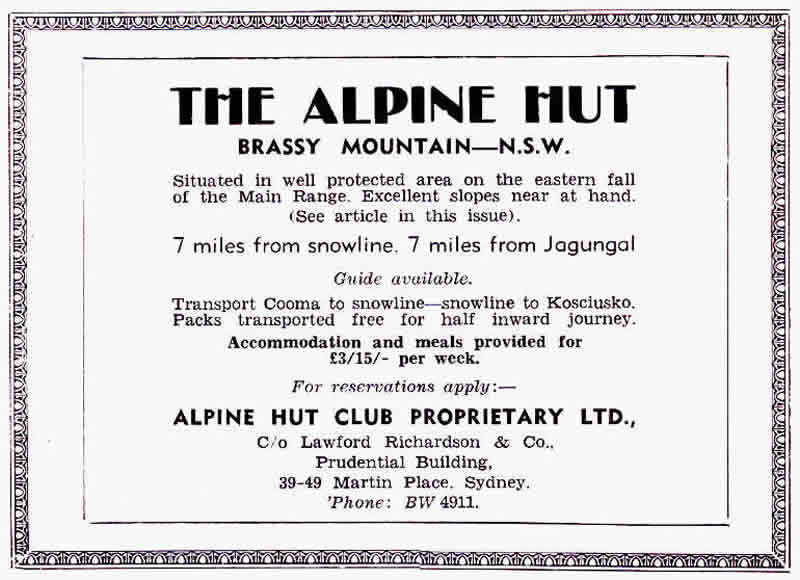Article Index
![Photo 1 [Warren Peck, September 1964] AAC2-01MtKosciLak AlbinaLodge](/images/heritage/part2/mag/AAC2-01MtKosciLak%20AlbinaLodge.jpg) |
| Our first installment of ski heritage photos showed the building of the AAC's first hut, which overlooked Lake Albina north of Mt. Kosciuszko. But before presenting photos of the building of the AAC's second and third Main Range huts, we want to take you back to the 1940's when skiers penetrated deep into the Snowy Mountains "Back Country" in search of more challenging slopes than could be readily accessed from the then existing NSW ski resorts at Kiandra, Kosciusko Hotel and the Chalet, Charlotte's Pass. |
|
The seven miles (11km) from the snowline to the Alpine Hut at 1670m altitude, was a challenge in an area without roads. Ski runs had been cleared on the slopes of Big Brassy (summit 1945m elevation) behind the Alpine hut, which also was at a gateway into a vast area of excellent ski fields including Mt. Jagungal (2061m), the highest Australian mountain north of the Kosciuszko Main Range. |
![Photo 2 [Frank Leyden, 1945] AAC2-02HorsesSnowyPlains](/images/heritage/part2/mag/AAC2-02HorsesSnowyPlains.jpg) Packhorses could usually get through the snow to the Brassy Gap, about 3.5 miles (5.5km) from the hut with packs and bags of food and other supplies. Then it was necessary to ski the remaining distance whilst carrying heavy packs. However the Second World War had started only months after the Alpine Hut had been opened. The graziers who were going to stock the hut with food, act as guides and supply the packhorses, were called up to serve in the Australian Army. As a result, Frank Leyden (AAC Foundation Member), who skied in to Alpine Hut each winter between 1942 and 1946, only had the services of the packhorses for his 1945 ski holiday at the hut. Photo No. 2 shows the loaded horses at the "Snowy Plains House" (Napthalis Homestead) just below the snowline of that year at about 1380m elevation. From here the horses were able to carry the packs about 3.3 miles (5.1km) to Brassy Gap at 1615m elevation. Packhorses could usually get through the snow to the Brassy Gap, about 3.5 miles (5.5km) from the hut with packs and bags of food and other supplies. Then it was necessary to ski the remaining distance whilst carrying heavy packs. However the Second World War had started only months after the Alpine Hut had been opened. The graziers who were going to stock the hut with food, act as guides and supply the packhorses, were called up to serve in the Australian Army. As a result, Frank Leyden (AAC Foundation Member), who skied in to Alpine Hut each winter between 1942 and 1946, only had the services of the packhorses for his 1945 ski holiday at the hut. Photo No. 2 shows the loaded horses at the "Snowy Plains House" (Napthalis Homestead) just below the snowline of that year at about 1380m elevation. From here the horses were able to carry the packs about 3.3 miles (5.1km) to Brassy Gap at 1615m elevation. |
|
|
Alpine Hut was (it burnt down in a bushfire in 1979) an ideal base for skiing and touring. The return trip to Mt. Jagungal (Photo No. 6) took about 6 hours and the route passed close to Mawson's Hut (Photo No. 7).![Photo 5 [Frank Leyden, 1943] AAC2-05AlpineHutAug1943](/images/heritage/part2/mag/AAC2-05AlpineHutAug1943.jpg) ![Photo 6 [Warren Peck, 1967] AAC2-06MountJagungalfromS](/images/heritage/part2/mag/AAC2-06MountJagungalfromS.jpg) ![Mawson’s Hut Photo 7 [Frank Leyden, 1943]] AAC2-07MawsonsHut](/images/heritage/part2/mag/AAC2-07MawsonsHut.jpg) |

 Many of the huts dotted across the mountains only provided basic shelter for those supervising summer grazing, but there was the Grey Mare Hut attached to a gold mine and, in 1939, the Alpine Hut was built specifically for skiers.
Many of the huts dotted across the mountains only provided basic shelter for those supervising summer grazing, but there was the Grey Mare Hut attached to a gold mine and, in 1939, the Alpine Hut was built specifically for skiers.![Photo 3 [Frank Leyden, 1943] AAC2-03AlpineHutat1670m](/images/heritage/part2/mag/AAC2-03AlpineHutat1670m.jpg) In heavy snow years, such as 1943, the snowline was a further 4 miles down the mountain at about 1200m elevation. That year the 10 mile (16km) ski journey into Alpine Hut through deep snow took 24 hours, including an overnight stop in Fletchers Hut, a graziers hut at about 1340m elevation. In winter the hut provided heated bunk room accommodation for about 16 persons, a large eating / lounge / kitchen area, a room for a cook and sometimes a live-in cook. But there was no running hot and cold water. Water was hand-pumped daily from a nearby creek into a large, open container a little larger than a baby's bath. Showering involved heating a bucket of water and then filling a crude camping shower with an on/off tap leading to a shower rose.
In heavy snow years, such as 1943, the snowline was a further 4 miles down the mountain at about 1200m elevation. That year the 10 mile (16km) ski journey into Alpine Hut through deep snow took 24 hours, including an overnight stop in Fletchers Hut, a graziers hut at about 1340m elevation. In winter the hut provided heated bunk room accommodation for about 16 persons, a large eating / lounge / kitchen area, a room for a cook and sometimes a live-in cook. But there was no running hot and cold water. Water was hand-pumped daily from a nearby creek into a large, open container a little larger than a baby's bath. Showering involved heating a bucket of water and then filling a crude camping shower with an on/off tap leading to a shower rose.![Photo 4 [Frank Leyden, 1943] AAC2-04ViewEastfromBigBrassy](/images/heritage/part2/mag/AAC2-04ViewEastfromBigBrassy.jpg)